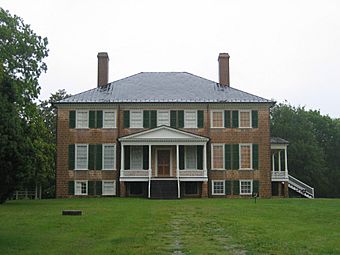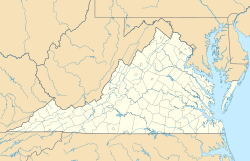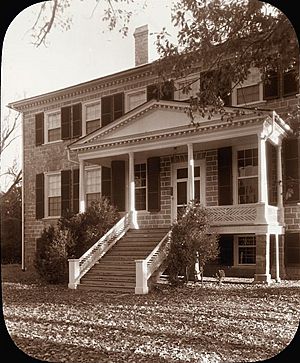Prestwould facts for kids
|
Prestwould
|
|

Prestwould, June 2009
|
|
| Location | N of Clarksville, Virginia |
|---|---|
| Area | 46 acres (19 ha) |
| Built | 1795 |
| NRHP reference No. | 69000260 |
Quick facts for kids Significant dates |
|
| Added to NRHP | October 1, 1969 |
| Designated NHL | July 31, 2003 |
Prestwould is a very old and important house located near Clarksville, Virginia. It is in Mecklenburg County, Virginia. This historic home is one of the best-preserved "plantation houses" in Southside Virginia. A plantation was a large farm where crops were grown.
Prestwould was built for Sir Peyton Skipwith, 7th Baronet Skipwith. He was a wealthy landowner. Sir Peyton and his family moved into Prestwould in 1797. Today, Prestwould is a museum. It has been open to the public since 1963. It was recognized as a special historic place in 1969. Later, in 2003, it became a National Historic Landmark. This means it is a place of great importance to the history of the United States.
Prestwould is located on the north side of the Roanoke River. It is about one mile inland from the river. You can visit Prestwould for tours from April to October. You can also make an appointment to visit at other times.
Contents
Exploring Prestwould: A Historic Home
Prestwould Plantation covers almost 46 acres today. The main house sits on a hill. From there, you can see the John H. Kerr Reservoir. This reservoir was created in the 1950s when a dam was built.
What Does the Plantation Look Like?
The Prestwould complex includes eight buildings. All of these buildings were built before 1830. Most of them date back to the 1780s. The main house is made of stone. It has a special roof called a hip roof. It also has two chimneys inside.
The front of the house is very grand. It has seven sections, called bays. There are columns that support a gabled porch. This porch covers the middle three sections of the first floor. Two other sides of the house also have similar porches.
Other Buildings at Prestwould
The other buildings on the property are made of wood. These include an office and a plantation store. There are also buildings that were once slave quarters. These were the living areas for enslaved people. Additionally, there are two smokehouses. Smokehouses were used to preserve meat.
See also




